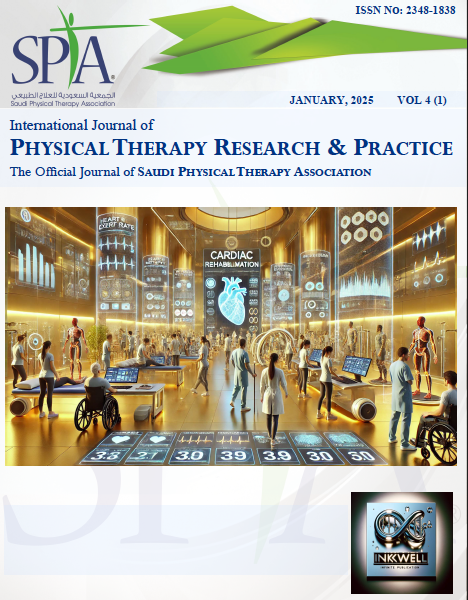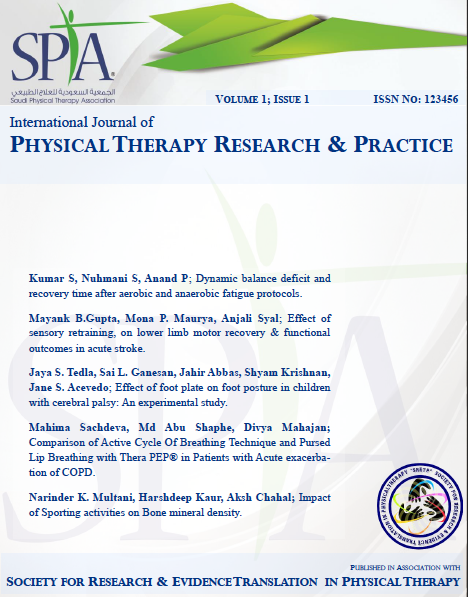The Impact of Physiotherapy on Motor Function in a Child Recovering from Human Coronavirus NL63: A Case Report
DOI:
https://doi.org/10.62464/ijoprp.v4i1.87Keywords:
case report, coronavirus, HCoV-NL63, developmental delay, pediatricAbstract
Backgrounds: This case report aims to investigate potential neurological complications in children following Human Coronavirus NL63 (HCoV-NL63) infection and evaluate the effectiveness of 12-week physiotherapy intervention in improving motor function in this child. Methods: This case study examines a four-year-old male patient with multiple health dysfunctions following an HCoV-NL63 infection. A 12-week rehabilitation program including whole body vibration, lower extremities strengthening exercise, stairs climbing, balance exercise, and obstacles course was performed. The evaluation included the Pediatric Balance Scale (PBS), the Denver Developmental Screening Test (DDST), and the 10-Meter Walking Test (10MWT) to assess motor abilities and walking speed. Results: The participant demonstrated clinically meaningful improvement in motor function. The PBS score increased from 33 at baseline to 49 at 12 weeks. Walking speed increased from 0.56 meters/second at baseline to 1.43 meters/second. The DDST revealed improvement in fine motor skills such as copying a circle and drawing a person with three body parts Conclusions: This case report demonstrates that a 12-week physiotherapy program can lead to substantial improvements in motor function, including balance and walking speed, in a child with developmental delays following a severe HCoV-NL63 infection. However, the study also highlights the broader neurological and developmental populations. While respiratory symptoms are typically the focus of HCoV-NL63 treatment, this case report suggests that clinician should also consider potential long-term neurological effects, especially in severe cases. The child’s history of seizures and global developmental delay points to the need for more research into the virus’s impact on brain function and development.
References
Almqvist, J., Granberg, T., Tzortzakakis, A., Klironomos, S., Kollia, E., Öhberg, C., et al. (2020). Neurological manifestations of coronavirus infections: A systematic review. Annals of Clinical and Translational Neurology, 7(10), 2057–2071. https://doi.org/10.1002/acn3.51166
Cadieux, J. M., Pyhala, S. L., & Johnson, J. V. (2023). Pediatric walking speed normal reference values in a local population. Pediatric Physical Therapy, 35(3), 314–320.
Cadman, D., Chambers, L. W., Walter, S. D., Feldman, W., & Frcp, C. (1984). The usefulness of the Denver Developmental Screening Test to predict kindergarten problems in a general community population. American Journal of Public Health, 74(10).
Chathappady House, N. N., Palissery, S., & Sebastian, H. (2021). Corona viruses: A review on SARS, MERS, and COVID-19. Microbiology Insights, 14, 117863612110024.
Chen, C., Shen, I., Chen, C., Wu, C., Liu, W.-Y., & Chung, C. (2013). Validity, responsiveness, minimal detectable change, and minimal clinically important change of Pediatric Balance Scale in children with cerebral palsy. Research in Developmental Disabilities, 34(3), 916–922.
Chiu, S. S., Hung Chan, K., Wing Chu, K., Kwan, S. W., Guan, Y., & Man Poon, L. L., et al. (2005). Human coronavirus NL63 infection and other coronavirus infections in children hospitalized with acute respiratory disease in Hong Kong, China. Clinical Infectious Diseases, 40(12), 1721–1729.
Conroy, C., & Logan, D. E. (2014). Pediatric multidisciplinary and interdisciplinary teams and interventions. Clinical Practice in Pediatric Psychology, 2(2), 93–108. https://doi.org/10.1037/cpp0000063
de Baptista, C. R. J. A., Vicente, A. M., Souza, M. A., Cardoso, J., Ramalho, V. M., & Mattiello-Sverzut, A. C. (2020). Methods of 10‐meter walk test and repercussions for reliability obtained in typically developing children. Rehabilitation Research and Practice, 2020(1), 4209812.
Fatima, U., Gondal, J. I., Liaqat, S., & Ansar, A. (2014). The effect of basic physiotherapy interventions along with Bobath technique in children with neurodevelopmental delay. International Journal of Engineering Science and Mathematics, 3(3), 33–50.
Fouchier, R. A. M., Hartwig, N. G., Bestebroer, T. M., Niemeyer, B., de Jong, J. C., Simon, J. H., et al. (2004). A previously undescribed coronavirus associated with respiratory disease in humans. Proceedings of the National Academy of Sciences, 101(16), 6212–6216.
Franjoine, M. R., Darr, N., Held, S. L., Kott, K., & Young, B. L. (2010). The performance of children developing typically on the Pediatric Balance Scale. Pediatric Physical Therapy, 22(4), 350–359.
Franjoine, M. R., Gunther, J. S., & Taylor, M. J. (2003). Pediatric balance scale: A modified version of the Berg Balance Scale for the school-age child with mild to moderate motor impairment. Pediatric Physical Therapy, 15(2), 114–128.
Gould, E., Dixon, D. R., Najdowski, A. C., Smith, M. N., & Tarbox, J. (2011). A review of assessments for determining the content of early intensive behavioral intervention programs for autism spectrum disorders. Research in Autism Spectrum Disorders, 5(3), 990–1002.
Gupta, S., Pande, A., & Swati. (2022). Moving skills—a contributing factor in developmental delay. Soft Computing: Theories and Applications (SoCTA 2020, Vol 1), 33–40.
Kane, K. J., Lanovaz, J., Bisaro, D., Oates, A., & Musselman, K. E. (2016). Preliminary study of novel, timed walking tests for children with spina bifida or cerebral palsy. SAGE Open Medicine, 4, 2050312116658908.
King, G., Tucker, M. A., Baldwin, P., Lowry, K., Laporta, J., & Martens, L. (2002). A life needs model of pediatric service delivery: Services to support community participation and quality of life for children and youth with disabilities. Physical & Occupational Therapy in Pediatrics, 22(2), 53–77.
Li, X., He, Y., Wang, D., & Rezaei, M. J. (2024). Stroke rehabilitation: From diagnosis to therapy. Frontiers in Neurology, 15, 1402729. https://doi.org/10.3389/fneur.2024.1402729
Liu, D. X., Liang, J. Q., & Fung, T. S. (2021). Human coronavirus-229E, -OC43, -NL63, and -HKU1 (Coronaviridae). Encyclopedia of Virology, 428.
Moës, E., Vijgen, L., Keyaerts, E., Zlateva, K., Li, S., Maes, P., et al. (2005). A novel pancoronavirus RT-PCR assay: Frequent detection of human coronavirus NL63 in children hospitalized with respiratory tract infections in Belgium. BMC Infectious Diseases, 5, 1–10.
Paredes-Amaya, C. C., Matta-Cortes, L., & Zea-Vera, A. F. (2022). Severe coronavirus HCoV-NL63 pneumonia in a patient receiving blinatumomab with secondary antibody deficiency in COVID-19 times. Germs, 12(2), 292–297.
Peiris, J. S. M. (2012). Coronaviruses. Medical Microbiology, 587–593. https://doi.org/10.1016/B978-0-7020-4089-4.00072-X
Piešová, M., & Mach, M. (2020). Impact of perinatal hypoxia on the developing brain. Physiological Research, 69(2), 199–213.
Pyrc, K., Bosch, B. J., Berkhout, B., Jebbink, M. F., Dijkman, R., Rottier, P., et al. (2006). Inhibition of human coronavirus NL63 infection at early stages of the replication cycle. Antimicrobial Agents and Chemotherapy, 50(6), 2000–2008.
Pyrc, K., Jebbink, M. F., Berkhout, B., & Van der Hoek, L. (2004). Genome structure and transcriptional regulation of human coronavirus NL63. Virology Journal, 1, 1–11.
Santos, J. A. T., Ayupe, K. M. A., Lima, A. L. O., Albuquerque, K. A. de, Morgado, F. F. da R., & Gutierres Filho, P. J. B. (2022). Psychometric properties of the Brazilian version of the Denver II: Developmental screening test. Ciência & Saúde Coletiva, 27, 1097–1106.
Sung, J. Y., Lee, H. J., Eun, B. W., Kim, S. H., Lee, S. Y., & Lee, J. Y., et al. (2010). Role of human coronavirus NL63 in hospitalized children with croup. Pediatric Infectious Disease Journal, 29(9), 822–826.
van der Hoek, L., Ihorst, G., Sure, K., Vabret, A., Dijkman, R., de Vries, M., et al. (2010). Burden of disease due to human coronavirus NL63 infections and periodicity of infection. Journal of Clinical Virology, 48(2), 104–108.
van der Hoek, L., Pyrc, K., Jebbink, M. F., Vermeulen-Oost, W., Berkhout, R. J. M., & Wolthers, K. C., et al. (2004). Identification of a new human coronavirus. Nature Medicine, 10(4), 368–373.
Watson, M. J. (2002). Refining the ten-meter walking test for use with neurologically impaired people. Physiotherapy, 88(7), 386–397.
Wen, C., Sun, L., Zhao, M. C., Duan, S. X., Wang, L., & Cui, X. W. (2022). Clinical study of human coronavirus NL63, OC43, 229E, HKU1 infections in hospitalized children from 2015 to 2020. Infection and Drug Resistance, 15(February), 1093–1101.
Wiart, L. (2015). Goal setting in pediatric rehabilitation. Rehabilitation Goal Setting: Theory, Practice, and Evidence, 291–304.
Yi, S.-H., Hwang, J. H., Kim, S. J., & Kwon, J.-Y. (2012). Validity of pediatric balance scales in children with spastic cerebral palsy. Neuropediatrics, 43(6), 307–313. https://doi.org/10.1055/s-0032-1331812

Downloads
Published
Versions
- 2025-02-01 (2)
- 2025-01-31 (1)
Issue
Section
License
Copyright (c) 2025 International Journal of Physical Therapy Research & Practice

This work is licensed under a Creative Commons Attribution-NonCommercial-NoDerivatives 4.0 International License.



